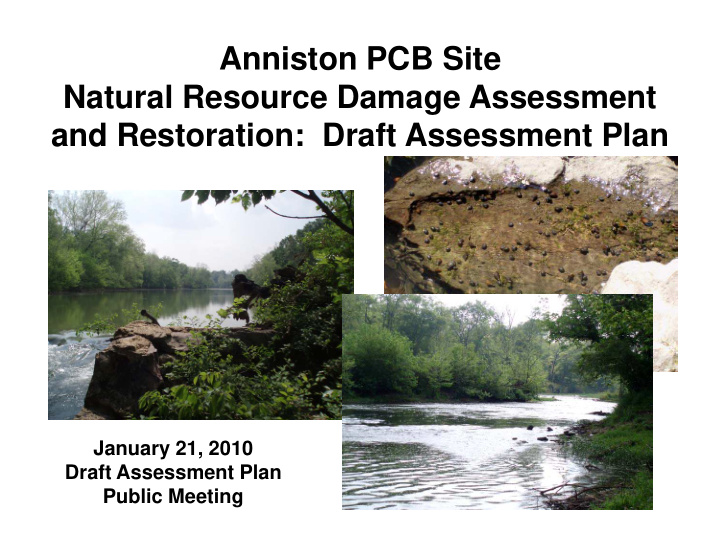



Anniston PCB Site Natural Resource Damage Assessment and Restoration: Draft Assessment Plan January 21, 2010 Draft Assessment Plan Public Meeting
Anniston PCB Site Natural Resource Trustees Alabama Department of Conservation and Natural Resources
Presentation Objectives - Overview of the Natural Resource Damage Assessment and Restoration (NRDAR) process. - Update on the NRDAR activities at the Anniston PCB Site. - Overview of draft Anniston NRDAR Assessment Plan. - Review schedule. - Questions?
What is Natural Resource Damage Assessment? It is the process used by natural resource trustees to determine the nature and extent of injury to trust natural resources caused by an oil spill or release of a hazardous substance.
General Steps in the NRDAR Process - Pre-assessment Screen - Assessment Planning - Injury Determination - Injury Quantification - Damage Calculation - Restoration
NRDAR Process Superfund ERA Process Screening-level Pre-Assessment Screen Problem Formulation Assessment Plan Study Design Injury Determination Field Reconnaissance Site Investigation Injury Quantification Risk Characterization Damage Assessment Risk Management Remediation and Restoration Construction & Monitoring
What is Natural Resource Damage Assessment? concepts: … the process used by natural resource trustees to determine the nature and extent of injury to a trust natural resource caused by a release of a hazardous substance for the purpose of restoring the natural resource or acquiring its equivalent.
Anniston PCB Site EPA Superfund Operable Units - Operable Unit 1 – Residential Areas - Operable Unit 2 – Non-Residential Areas - from facility to HWY 78 - Operable Unit 3 – Solutia Facility - includes South and West End Landfills - Operable Unit 4 – Choccolocco Creek and associated floodplain
Anniston PCB Site Neely Henry NRDAR Study Area Lake Anniston Logan Martin Lake Superfund Site Lay Lake Red Denotes Fish Consumption Advisories Mitchell Lake
What is Natural Resource Damage Assessment? concepts: … the process used by natural resource trustees to determine the nature and extent of injury to trust natural resources caused by release of a hazardous substance.
Injury … any adverse change in the condition of a resource caused by exposure to contaminants, including response actions
Examples of Injuries to Fish and Wildlife • Death • Disease • Cancer • Genetic Mutations • Physical Deformities • Behavioral Abnormalities
What is Natural Resource Damage Assessment? concepts: … the process used by natural resource trustees to determine the nature and extent of injury to trust natural resources caused by release of a hazardous substance.
Anniston PCB Site Trust Resources - surface water - groundwater - soils - sediment - benthos - mollusks - fish (and sportfishing) - terrestrial invertebrates - reptiles and amphibians - birds - mammals - threatened/endangered species (12)
What is Natural Resource Damage Assessment? concepts: … the process used by natural resource trustees to determine the nature and extent of injury to trust resources caused by releases of hazardous substances.
Anniston PCB Site Hazardous Substances (Chemicals of Concern) - PCBs - lead, mercury and other metals - organophosphate pesticides - chlorophenols - solvents - others
What is Natural Resource Damage Assessment? bottom-line: … NRDA is designed to compensate the environment and public for injuries to natural resources resulting from the release of hazardous substances - compensation achieved through: - restoration, rehabilitation, replacement of injured resources
What Is Restoration? Returning resources to conditions that existed prior to the release of hazardous substances.
Examples of Restoration • Enhance or restore quality of existing habitat (examples - planting trees, restoring streams, etc.) • Increase populations through reintroduction or restocking (examples - stocking mussels or fish) • Public access and education (examples - providing nature trails, fishing access, educational kiosks, etc.)
Creation of riparian buffers benefits wildlife and improves water quality
Anniston PCB Site NRDAR - Where are we in the NRDAR Process?
Anniston PCB Site NRDAR - Status - Pre-assessment Screen: Final - February 2005 - Assessment Planning: Draft Stage 1 Assessment Plan November 2009 - Injury Determination: Ongoing - Injury Quantification - Damage Calculation - Restoration
Anniston PCB Site Assessment Plan (draft)
Anniston PCB Site Assessment Plan (draft) Chapter 1: Introduction - overview of the NRDA Process - summary of the Anniston PCB Site Pre-Assessment Screen - description of the intent and organization of the Plan - details on the Public Comment process
Anniston PCB Site Assessment Plan (draft) Chapter 2: Background - description of assessment area - site history - hazardous substance releases - overview of Superfund activities
Anniston PCB Site Assessment Plan (draft) Chapter 3: Authorities - review of legal authorities - identification of natural resources considered in the NRDA
Anniston PCB Site Assessment Plan (draft) Chapter 4: Coordination and Previous Actions of Trustees - Anniston PCB Site Trustee Team
Anniston PCB Site Assessment Plan (draft) Chapter 5: Confirmation of Exposure - overview of available information demonstrating a NRDAR is warranted - evaluates available data for: - surface water resources - groundwater resources - geological resources - biological resources
Anniston PCB Site Assessment Plan (draft) Chapter 6: Stage 1 Injury Assessment - describes proposed injury assessment approach - identifies data sources - evaluates exposure pathways - defines injury criteria
Anniston PCB Site Assessment Plan (draft) Chapter 7: Damage Determination - describes proposed approach to calculate costs of restoration or other compensation - describes restoration planning objectives and processes - describes coordination with the Superfund action
Anniston PCB Site Assessment Plan (draft) Chapter 8: References
Anniston PCB Site Assessment Plan (draft) Appendices A: Threatened and Endangered Species B: List of Chemicals of Potential Concern
Anniston PCB Site Draft NRDAR Assessment Plan • A copy may be downloaded at http://www.fws.gov/daphne or • Request a copy from: Karen Marlowe Propst Hall, Rm. 229 800 Lakeshore Drive Birmingham, AL 35229-2234 (205)726-2667 karen_marlowe@fws.gov
Anniston PCB Site Draft NRDAR Assessment Plan • Comment period is open until January 31, 2010. • Send comments to: Karen Marlowe Propst Hall, Rm. 229 800 Lakeshore Drive Birmingham, AL 35229-2234 (205)726-2667 karen_marlowe@fws.gov
Questions? Contact: Karen Marlowe Propst Hall, Rm. 229 800 Lakeshore Drive Birmingham, AL 35229-2234 (205) 726-2667 karen_marlowe@fws.gov
Recommend
More recommend